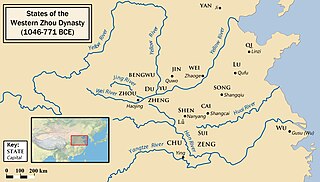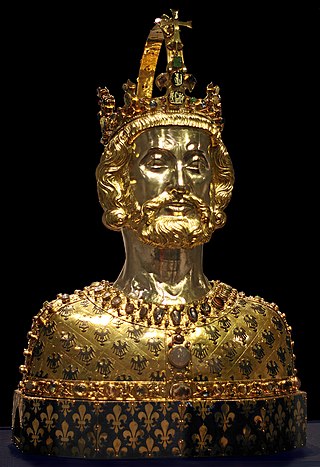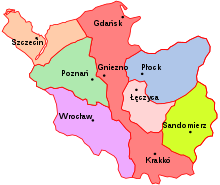
The history of Europe is traditionally divided into four time periods: prehistoric Europe, classical antiquity, the Middle Ages, and the modern era.

The Treaty of Berlin was signed on 13 July 1878. In the aftermath of the Russian victory against the Ottoman Empire in the Russo-Turkish War of 1877–1878, the major powers restructured the map of the Balkan region. They reversed some of the extreme gains claimed by Russia in the preliminary Treaty of San Stefano, but the Ottomans lost their major holdings in Europe. It was one of three major peace agreements in the period after the 1815 Congress of Vienna. It was the final act of the Congress of Berlin and included Great Britain and Ireland, Austria-Hungary, France, Germany, Italy, Russia and the Ottoman Empire. Chancellor of Germany Otto von Bismarck was the chairman and dominant personality.

The Western Zhou was a period of Chinese history, approximately first half of the Zhou dynasty, before the period of the Eastern Zhou. It began when King Wu of Zhou overthrew the Shang dynasty at the Battle of Muye and ended when Quanrong pastoralists sacked its capital Haojing and killed King You of Zhou in 771 BC.
Modern humans evolved in Africa around 300,000 years ago and initially lived as hunter-gatherers. They migrated out of Africa during the Last Glacial Period and had populated most of the Earth by the time the Ice Age ended 12,000 years ago.
The early modern period is a historical period that is part of the modern period based primarily on the history of Europe and the broader concept of modernity. There is no exact date that marks the beginning or end of the period and its timeline may vary depending on the area of history being studied. In general, the early modern period is considered to have lasted from the 16th to the 19th centuries. In a European context, it is defined as the period following the Middle Ages and preceding the advent of modernity, sometimes defined as the "late modern period". In the context of global history, the early modern period is often used even in contexts where there is no equivalent "medieval" period.

The Patriotic Party, also known as the Patriot Party or, in English, as the Reform Party, was a political movement in the Polish–Lithuanian Commonwealth in the period of the Four-Year Sejm of 1788–1792, whose chief achievement was the Constitution of 3 May 1791. The reformers aimed to strengthen the ailing political machinery of the Commonwealth, to bolster its military, and to reduce foreign political influence, particularly that of the Russian Empire. It has been called the first Polish political party, though it had no formal organizational structure. The Party was inspired by the ideals of the French Revolution, and its name, proudly used by themselves, was a tribute to the Dutch Patriots.

The Kometopuli dynasty was the last royal dynasty in the First Bulgarian Empire, ruling from c. 976 until the fall of Bulgaria under Byzantine rule in 1018. The most notable member of the dynasty, Tsar Samuel, is famous for successfully resisting Byzantine conquest for more than 40 years. Sometimes the realm of the Cometopuli is called Western Bulgarian Kingdom or Western Bulgarian Empire.

The word Kleinstaaterei is a pejorative term coined in the early nineteenth century to denote the territorial fragmentation of Germany. While the term referred primarily to the territorial fragmentation of the German Confederation, it is also applied by extension to the even more extreme territorial fragmentation of the Holy Roman Empire. In this period, Germany was split into a great number of nearly sovereign small and medium-sized secular and ecclesiastical principalities and free imperial cities, some of which were little larger than a single town or the surrounding grounds of the monastery of an Imperial abbey. Estimates of the total number of German states at any time during the 18th century vary, ranging from 294 to 348, or more. However, the number of states rapidly decreased with the onset of German mediatisation in the early 19th century.
Fēngjiàn was a governance system in Ancient China and Imperial China, whose social structure formed a decentralized system of confederation-like government. The ruling class consisted of the Son of Heaven and aristocracy, and the lower class consisted of commoners categorized into four occupations. Elite bonds through affinal relations and submission to the overlordship of the king date back to the Shang dynasty, but it was the Western Zhou dynasty when the Zhou kings enfeoffed their clan relatives and fellow warriors as vassals. Through the fengjian system, the king would allocate an area of land to a noble, establishing him as the ruler of that region and allowing his title and fief to be legitimately inherited by his descendants. This created large numbers of local autonomous dynastic domains.

The Theme of Bulgaria was a province of the Byzantine Empire established by Emperor Basil II after the conquest of Bulgaria in 1018. Its capital was Scupi and it was governed by a strategos. The theme of Bulgaria did not encompass the old Bulgarian lands between the Haimos Mountains and the river Danube, that included the former capitals Pliska and Preslav. This territory was administred independently and was considered as autonomous military unit, designated as Dristra, Paristrion or Paradunavon, meaning the “lands beside the Danube”.

Autokrator or Autocrator is a Greek epithet applied to an individual who is unrestrained by superiors. It has been applied to military commanders-in-chief as well as Roman and Byzantine emperors as the translation of the Latin title imperator. Its connection with Byzantine-style absolutism gave rise to the modern terms autocrat and autocracy. In Modern Greek, it means "emperor", and its feminine form is autokráteira (αὐτοκράτειρα).
Mongol campaigns in Central Asia occurred after the unification of the Mongol and Turkic tribes on the Mongolian plateau in 1206. Smaller military operations of the Mongol Empire in Central Asia included the destruction of surviving Merkit and Naimans and the conquest of Qara Khitai. These were followed by a major campaign against Khwarazm. Expansion into Central Asia began in 1209 as Genghis Khan sent an expedition to pursue rivals who had fled to the region and threatened his new empire. The Uyghur kingdom Qocho and leaders of the Karluks submitted voluntarily to the Mongol Empire and married into the imperial family. By 1218 the Mongols controlled all of Xinjiang and by 1221 all the territories of the former Khwarazmian Empire. In 1236, the Mongols defeated the eastern portions of Cumania and swept into Eastern Europe.

Namık Kemal was an Ottoman writer, poet, democrat, intellectual, reformer, journalist, playwright, and political activist who was influential in the formation of the Young Ottomans and their struggle for governmental reform in the Ottoman Empire during the late Tanzimat period, which would lead to the First Constitutional Era in the Empire in 1876. Kemal was particularly significant for championing the notions of freedom and fatherland in his numerous plays and poems, and his works would have a powerful impact on the establishment of and future reform movements in Turkey, as well as other former Ottoman territories. He is often regarded as being instrumental in redefining Western concepts like natural rights and constitutional government.
Avariz was a property tax in the Ottoman Empire, an annual cash tax paid by households registered in a defter.

King is the title given to a male monarch in a variety of contexts. A king is an absolute monarch if he holds the powers of government without control, or the entire sovereignty over a nation; he is a limited monarch if his power is restrained by fixed laws; and he is an absolute, when he holds the whole legislative, judicial, and executive power, or when the legislative or judicial powers, or both, are vested in other people by the king. Kings are hereditary sovereigns when they hold the powers of government by right of birth or inheritance, and elective when raised to the throne by choice.

This is a timeline of the Qing dynasty (1644–1912).

This is a timeline of the Era of Fragmentation, the period of Tibetan history lasting from the death of the Tibetan Empire's last emperor, Langdarma, in 842 until Drogön Chögyal Phagpa gained control over the three provinces of Tibet in 1253 under Mongol rule.













